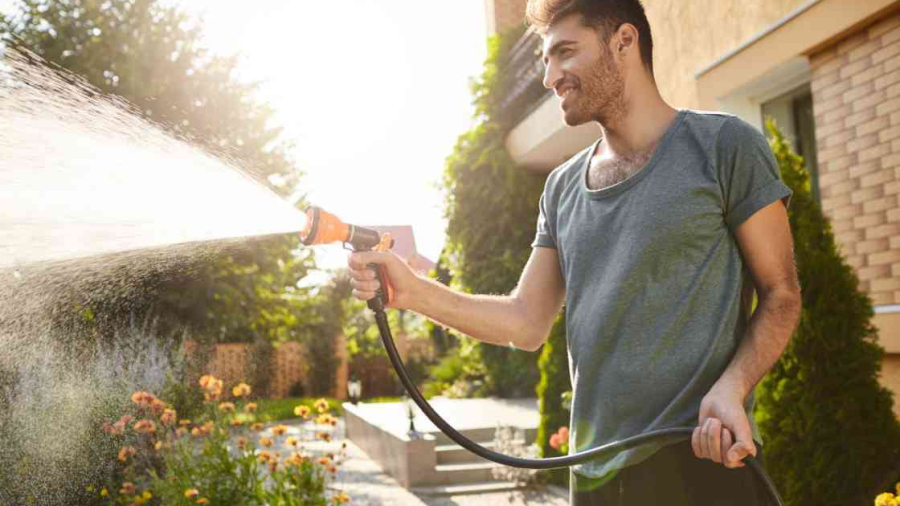Let’s face it, scrubbing away dirt and grime can be a real pain. Ever wished there was a faster, easier way to get your house sparkling clean? Enter the pressure washer: your new best friend in the battle against outdoor gunk.
This guide is here to turn you from a pressure washing newbie into a pro in no time. We’ll break down everything you need to know, from choosing the right washer to safety tips and tricks. Prepare to update the exterior of your house with confidence!
Understanding Pressure Washers
Think of a pressure washer as a superpowered hose. It blasts water at high pressure, making it way easier to remove dirt, mold, mildew, and grime from all sorts of outdoor surfaces.
Electric and gas-powered pressure washers are the two primary varieties.
- Electric pressure washers: These are quieter, lighter, and generally easier to use. Perfect for smaller jobs like cleaning your patio furniture or driveway.
- Gas-powered pressure washers: Need to tackle a tough job like stripping paint or cleaning a giant deck? Gas-powered washers pack a bigger punch, but they’re also louder and require more maintenance.
Choosing the Right Pressure Washer
Not all pressure washers are created equal. Here’s what to consider when picking yours:
- Power: Look for two numbers: PSI (pounds per square inch) and GPM (gallons per minute). Higher PSI means more cleaning power, but keep in mind that too much pressure can damage some surfaces. GPM tells you how much water the washer uses per minute – more GPM means faster cleaning.
- Features: Here are some handy extras to look for:
- Spray Nozzles: Different nozzles create different spray patterns, so you can choose the right one for the job at hand.
- Extension Wands: Reach high areas without breaking a sweat with an extension wand.
- Soap Dispensers: Make cleaning a breeze by adding soap directly to the water stream.
Safety Gear Essentials
Safety first! Before you start blasting away, gear up with these essentials:
- Eye protection: A stray spray of water at high pressure can do some serious damage to your eyes. Wear safety goggles – no ifs, ands, or buts!
- Gloves: Protect your hands from the pressure and any cleaning chemicals you might be using.
- Long pants and closed-toe shoes: This protects your skin from splashes and helps prevent slips and falls.
Getting Started with Pressure Washing
Now that you’re organized and prepared, let’s get started! Here’s how to tackle your first pressure washing project:
- Clear the area: Move any furniture, plants, or decorations that could get damaged by the spray.
- Protect delicate surfaces: Cover windows, doors, and electrical outlets with plastic sheeting.
- Test on an inconspicuous area: Before you go all out, try the pressure washer on a hidden spot to make sure it won’t damage the surface. Use the appropriate pressure washer wand and nozzle for the test area.
Pressure Washing Techniques
Ready to unleash the cleaning power? Here are some basic pressure washing techniques to keep in mind:
- Maintain a safe distance: Hold the wand at the recommended distance from the surface (check your user manual for specifics).
- Sweeping motion is key: Move the spray nozzle back and forth to avoid streaking.
- Work from top to bottom: This prevents dirty runoff from staining areas you’ve already cleaned.
Pro Tip: For different surfaces around your house, you might need to adjust your technique or nozzle. We’ll cover specific tips for cleaning concrete, wood, siding, and furniture in the next section!
Conquering Different Surfaces with Your Pressure Washer
Now that you’ve mastered the basics, let’s get specific! Here are some tips for pressure washing common household surfaces:
- Concrete driveways and patios: Blast away dirt, grime, and mildew with a high-pressure nozzle. Be careful not to etch the concrete – adjust the pressure if needed.
- Wood decks and fences: For wood surfaces, use a lower pressure setting and a fan nozzle to avoid damaging the wood grain. If your pressure washer hose leaks or bursts while cleaning the deck, stop immediately and follow the manufacturer’s instructions for hose repair.
- Siding (vinyl, wood, brick): Choose the right nozzle for your siding material – a high-pressure setting on delicate vinyl can cause damage.
- Outdoor furniture: Give your patio furniture a refresh with a quick pressure wash. Start with a low-pressure setting and work your way up if needed.
Important Safety Precautions
Remember, pressure washers are powerful tools, so always prioritize safety:
- Never point the pressure washer at yourself or others: This seems obvious, but it’s worth mentioning. A high-pressure stream can cause serious injury.
- Maintain a firm grip on the spray wand: The force of the water can push back, so hold on tight!
- Be aware of electrical hazards: Avoid spraying near electrical outlets or wires. Water and electricity don’t mix!
- Use caution around windows and delicate surfaces: A high-pressure blast can crack glass or damage delicate surfaces. Use a lower pressure setting or a wider spray pattern if needed.
Maintaining Your Pressure Washer
Taking care of your pressure washer will ensure it lasts for years to come. Here’s what to do:
- Follow the manufacturer’s instructions: Your user manual will have specific cleaning and storage instructions for your pressure washer model.
- Winterize if necessary: If you live in a cold climate, you’ll need to winterize your pressure washer to prevent water from freezing and damaging the internal components. (Avoid mentioning specific brands or stores here.)
Conclusion
Pressure washing can be a game-changer for keeping your home’s exterior looking its best. It’s a faster and more efficient way to tackle tough cleaning jobs, leaving you with a sparkling clean house and a sense of accomplishment.
So, what are you waiting for? Grab your pressure washer (and this handy guide!), and get ready to transform your home!

